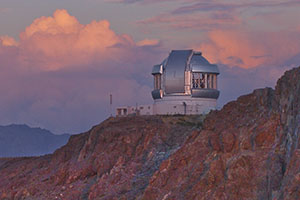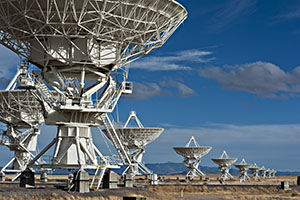The awards represent a significant milestone in the Dunlap’s mandate of developing innovative astronomical technology.
“The Dunlap Institute’s main mission is to develop innovative new approaches to astronomy, and these two new large grants are a terrific endorsement that we’re on the right track,” says Dunlap Director Prof. Bryan Gaensler.
“In particular, these projects superbly position the Dunlap Institute for national and international leadership. We’re excited to now flex our muscles and build big, new teams that will develop the tools and equipment needed for 21st century astronomy.”
Gaensler, who became the Institute’s director in January 2015, will be leading a project to build the infrastructure, computing capability, and expertise needed to process the overwhelming flood of information being produced by next-generation radio telescopes. The goal is to turn raw data into images and catalogues that astronomers can use to investigate cosmic magnetism, the evolution of galaxies, cosmic explosions, and more.
The Dunlap’s Prof. Suresh Sivanandam will develop an infrared spectrograph for the Gemini Observatory that will produce the most detailed and sensitive infrared images of the sky. With it, astronomers will be able to study some of the faintest, oldest and most distant objects in the Universe; probe the formation of stellar and planetary systems; and investigate galaxies in the early Universe.
Gaensler’s project will allow Canada to play a major role in the Very Large Array Sky Survey (VLASS), an ambitious new project to make a radio map of almost the entire sky in unprecedented detail. It will also help build the Canadian capacity needed to participate in what will be the largest and most powerful radio telescope ever constructed: the Square Kilometre Array.
Major partners include observatories and researchers at various universities across North America, including the US National Radio Astronomy Observatory, University of Alberta, University of Manitoba, and the National Research Council. It also includes collaborators from three significant new radio telescopes: the Canadian Hydrogen Intensity Mapping Experiment (CHIME), the Karl G. Jansky Very Large Array (VLA), and the Australian Square Kilometre Array Pathfinder (ASKAP).
The Gemini InfraRed Multi-Object Spectrograph (GIRMOS) is unlike any astronomical spectrograph in existence or being planned for the current suite of large telescopes, and will serve as a precursor to a spectrograph for the Thirty-Meter Telescope, now under construction in Hawaií. The spectrograph is designed for use on the 8-metre telescopes of the Gemini Observatory, the largest telescopes available to Canadian astronomers.
Major partners include Dalhousie University, the National Research Council, University of British Columbia, University of Victoria, Laval University, and Saint Mary’s University.
Plus, both projects provide ample opportunities for training students and postdoctoral fellows, and help position Canadian astronomers at the forefront of the next generation of astronomical discovery.
The annual CFI Innovation Fund awards support transformative and innovative research or technology development in areas where Canada currently is, or has the potential to be, competitive at a global level.
For Gaensler, the awards consist of $3.5 million from CFI, and nearly $6 million from provincial and other partners. The CFI money will flow to U of T and then on to the other partners; the rest will go directly to or stay with partners. For Sivanandam, over $5 million comes from CFI, with $7.8 million from provincial and other partners.
The awards were announced today by the Honourable Kirsty Duncan, Minister of Science, in a ceremony at the University of Manitoba, as part of a CFI investment of more than $554 million in 117 new infrastructure projects at 61 universities, colleges and research hospitals across Canada.
Additional notes:
1) In addition to those noted above, Prof. Gaensler’s project also includes the following partners: McGill University, Queen’s University, University of British Columbia, Cornell University, University of Minnesota, Netherlands Institute for Radio Astronomy, University of Cape Town, University of the Western Cape, and University of California Berkeley.
2) In addition to those partners noted above, Prof. Sivanandam’s project also includes York University and University of Manitoba.
3) The following statement has been added to the original release: “The CFI money will flow to U of T and then on to the other partners; the rest will go directly to or stay with partners.”
-30-
Contact information:
Prof. Bryan Gaensler, Director
Dunlap Institute for Astronomy & Astrophysics
University of Toronto
p: 416-978-6623
e: bgaensler@dunlap.utoronto.ca
web: www.dunlap.utoronto.ca/prof-bryan-gaensler/
Prof. Suresh Sivanandam
Dunlap Institute for Astronomy & Astrophysics
University of Toronto
p: 416-978-6779
e: sivanandam@dunlap.utoronto.ca
web: www.dunlap.utoronto.ca/suresh-sivanandam/
Chris Sasaki
Communications Coordinator | Press Officer
Dunlap Institute for Astronomy & Astrophysics
University of Toronto
p: 416-978-6613
e: csasaki@dunlap.utoronto.ca
The Dunlap Institute for Astronomy & Astrophysics at the University of Toronto is an endowed research institute with over 70 faculty, postdocs, students and staff, dedicated to innovative technology, ground-breaking research, world-class training, and public engagement. The research themes of its faculty and Dunlap Fellows span the Universe and include: optical, infrared and radio instrumentation; Dark Energy; large-scale structure; the Cosmic Microwave Background; the interstellar medium; galaxy evolution; cosmic magnetism; and time-domain science.
The Dunlap Institute, Department of Astronomy & Astrophysics, Canadian Institute for Theoretical Astrophysics, and Centre for Planetary Sciences comprise the leading centre for astronomical research in Canada, at the leading research university in the country, the University of Toronto.
The Dunlap Institute is committed to making its science, training and public outreach activities productive and enjoyable for everyone, regardless of gender, sexual orientation, disability, physical appearance, body size, race, nationality or religion.
###


